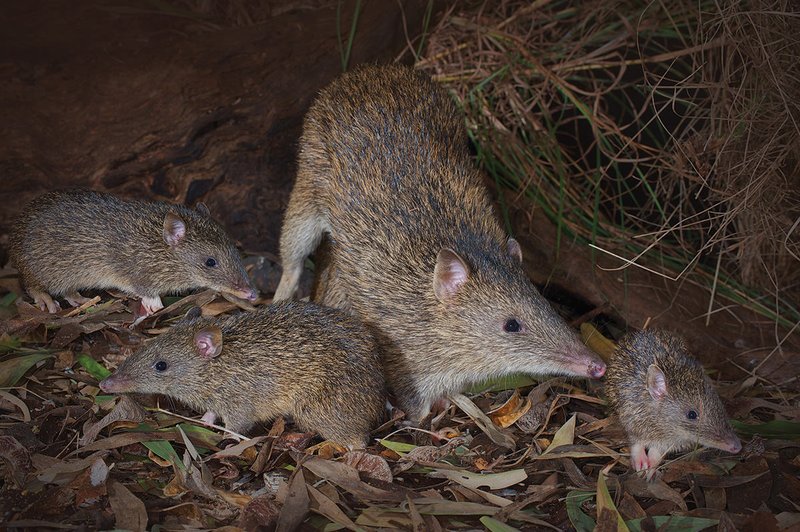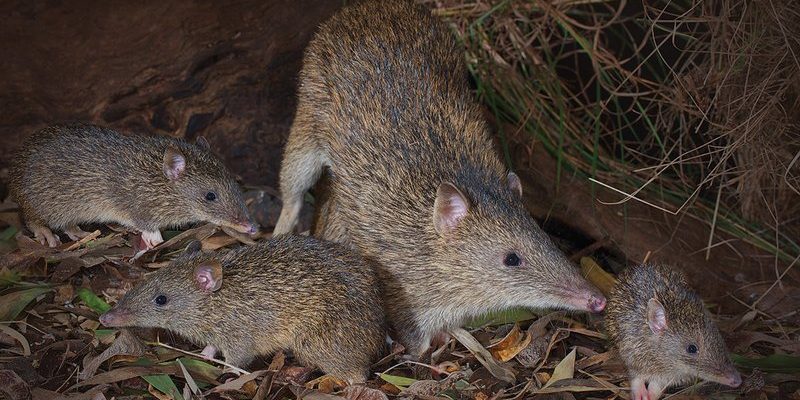
Have you ever heard of a bandicoot? These remarkable little marsupials are often overlooked but are truly fascinating creatures. Imagine a tiny, furry animal that scurries through the underbrush, its big ears perked up, sniffing out insects and plants. Bandicoots might look like a cross between a rat and a bunny, but they have their own unique charm and role in the ecosystem.
Originating from Australia and New Guinea, bandicoots are part of a group of marsupials that have a significant place in their habitats. They exhibit behaviors and characteristics that are both intriguing and endearing. So let’s dive into the world of bandicoots and explore everything from their habitats and diets to their conservation status.
What Are Bandicoots?
Bandicoots belong to the family Peramelidae and are small to medium-sized marsupials. Unlike their larger relatives like kangaroos, bandicoots take a different evolutionary path, being more closely related to animals like bilbies and the extinct thylacine. They have elongated snouts, sharp claws, and a slender build, making them agile foragers.
These marsupials are nocturnal, which means they are most active at night. Bandicoots use their keen sense of smell to find food, which primarily consists of insects, worms, and plant material. This diet plays a crucial role in the ecosystem, as they help control insect populations and disperse seeds through their foraging activities.
There are several species of bandicoots, including the Eastern Bandicoot and the Long-nosed Bandicoot. Each species has adapted to its environment in unique ways, contributing to the immense biodiversity found in Australia and New Guinea.
Physical Characteristics
Bandicoots are charming little creatures with distinguishing features. They typically weigh between 1 to 4 kilograms and can grow up to 30 centimeters in length, not including their tails. Their fur is usually coarse and can range from sandy brown to a darker hue, helping them blend into the forest floor.
One of the most notable physical traits of bandicoots is their large, rounded ears and pointed snouts. These features are not just for looks; they enhance their hearing and help them sniff out food more effectively. Their strong hind legs are built for digging, allowing them to access underground food sources.
Additionally, bandicoots possess a pouch similar to other marsupials. However, their pouch faces backward, which prevents dirt from entering while they dig. This unique adaptation is just one example of how these animals have evolved to thrive in their environments.
Habitat and Distribution
Bandicoots predominantly inhabit forested areas, grasslands, and shrublands across Australia and New Guinea. They prefer environments that have dense undergrowth, which provides shelter and abundant food sources. Unfortunately, habitat destruction due to urban development and agriculture poses a significant threat to their populations.
You might find bandicoots in places like the eucalyptus forests of eastern Australia or the wetlands of coastal regions. Their ability to adapt to various habitats is remarkable, but they are sensitive to changes in their environment. As human activities encroach on their natural homes, bandicoots face increasing challenges.
Interestingly, some species of bandicoots have adapted well to urban settings. They often venture into parks and gardens, where they may scavenge for food. However, this can lead to conflicts with humans, especially as they can dig up gardens in search of tasty treats.
Diet and Feeding Behavior
When it comes to food, bandicoots are omnivores, which means they eat both plants and animals. Their diet is mainly composed of insects, earthworms, and other invertebrates, as well as fruits and tubers they may find while foraging. They play an important role in soil aeration through their digging, allowing nutrients to circulate and promoting plant growth.
Bandicoots have a unique feeding method. They use their sharp claws to dig into the ground, creating small holes to unearth hidden treasures. Watching them forage can be quite a sight, as they enthusiastically sniff and scratch at the earth. Their nightly escapades help keep insect populations in check, making them key contributors to their ecosystems.
Moreover, bandicoots have adapted their feeding habits based on available food sources. During times of drought or food scarcity, they can shift their diet to include more plant matter. This flexibility ensures their survival in changing environments, showcasing their resilient nature.
Reproduction and Life Cycle
Bandicoot reproduction is fascinating and reflects their unique marsupial characteristics. After a gestation period of around 12 days, female bandicoots give birth to tiny, underdeveloped young. These newborns instinctively crawl into their mother’s pouch, where they latch onto a teat and continue to develop for several weeks.
Once the young are sufficiently developed, they begin to emerge from the pouch and explore their surroundings. This process is gradual, with mothers often carrying their young on their backs as they forage for food. Family dynamics can be quite tender, with mothers fiercely protective of their offspring.
The typical lifespan of a bandicoot in the wild ranges from 2 to 4 years, but they can live longer in captivity. Factors like predation, habitat loss, and environmental changes can significantly impact their life expectancy. Understanding their reproductive cycle helps conservationists work towards protecting these adorable marsupials.
Conservation Status
Bandicoots face various threats, primarily due to habitat destruction, climate change, and introduced predators like cats and foxes. Some species, such as the Eastern Bandicoot, are listed as endangered, making their conservation critical. Efforts are underway to protect their habitats and establish breeding programs to help boost their populations.
Conservation organizations work tirelessly to raise awareness about the plight of bandicoots. Initiatives involve habitat restoration and community education to reduce human-wildlife conflict. Preserving these unique animals is about maintaining biodiversity and ensuring ecosystems remain balanced.
You can also play a role in conservation by supporting wildlife-friendly practices and being mindful of your impact on the environment. Every effort counts, especially when it comes to protecting such delightful creatures as the bandicoot.
Interesting Facts About Bandicoots
| Species: | Eastern Bandicoot, Long-nosed Bandicoot, etc. |
| Size: | 30-40 cm in length |
| Weight: | 1-4 kg |
| Habitat: | Forests, grasslands, shrublands |
| Diet: | Insects, earthworms, fruits |
| Lifespan: | 2-4 years in the wild |
FAQ
What do bandicoots look like?
Bandicoots have a distinctive appearance with long, pointed snouts and large ears. Their fur is coarse and may vary in color from sandy brown to darker shades, which helps them blend into their surroundings. Depending on the species, they can weigh between 1 to 4 kilograms and grow up to about 30 centimeters in length.
Are bandicoots dangerous?
No, bandicoots are typically not dangerous to humans. They are shy and nocturnal creatures that prefer to avoid confrontation. If approached, they may flee rather than attack. However, like all wildlife, they should be respected and observed from a distance.
Where can I see bandicoots?
Bandicoots can be found in various habitats across Australia and New Guinea. While they are most active at night, some species have adapted to urban areas and can sometimes be seen in parks or gardens. Observing them in their natural habitat is the most rewarding experience, so visiting conservation areas or wildlife reserves can offer great opportunities.
How fast can bandicoots run?
Bandicoots may not be the fastest creatures, but they can run quite well for their size. They can reach speeds up to 20 kilometers per hour when threatened or startled. Their agility and sharp reflexes help them escape from predators, making them well-adapted to their environment.
What is the role of bandicoots in the ecosystem?
Bandicoots play an important role in their ecosystems by helping control insect populations and dispersing seeds. As they forage through the ground, they aerate the soil, promoting plant growth. This ecological contribution is vital to maintaining a healthy balance in their habitats.
How do bandicoots communicate?
Bandicoots communicate through various means, primarily through vocalizations. They may grunt or make high-pitched sounds to signal distress or communicate with their young. Body language is also crucial, as they may use postures and movements to express themselves, especially during mating seasons.
Are bandicoots social animals?
Bandicoots are generally solitary creatures, especially outside of the breeding season. While females may occasionally share a territory, they usually maintain separate living spaces. However, mothers are highly social with their young, offering care and protection until the juveniles are ready to fend for themselves.
Do bandicoots have any predators?
Yes, bandicoots have several natural predators, including birds of prey, snakes, and introduced species like cats and foxes. These threats can significantly impact bandicoot populations, particularly for vulnerable species. Conservation efforts often focus on managing these predator populations to protect bandicoots.
What are the conservation efforts in place for bandicoots?
Various conservation efforts are underway to protect bandicoots. These include habitat restoration projects, breeding programs in captivity, and community education initiatives to raise awareness. Organizations are working together to mitigate threats and ensure these unique marsupials continue to thrive in the wild.
Can bandicoots be kept as pets?
While bandicoots are fascinating animals, they are not suitable as pets. Their wild nature makes them challenging to care for in a domestic setting, and they have specific habitat and dietary needs that are difficult to replicate. Instead, it’s best to enjoy and appreciate them in their natural habitats.
Do bandicoots hibernate?
No, bandicoots do not hibernate. However, they may become less active during extremely hot or cold weather. They adapt to seasonal changes by adjusting their foraging patterns and behaviors, allowing them to survive in fluctuating environmental conditions.

